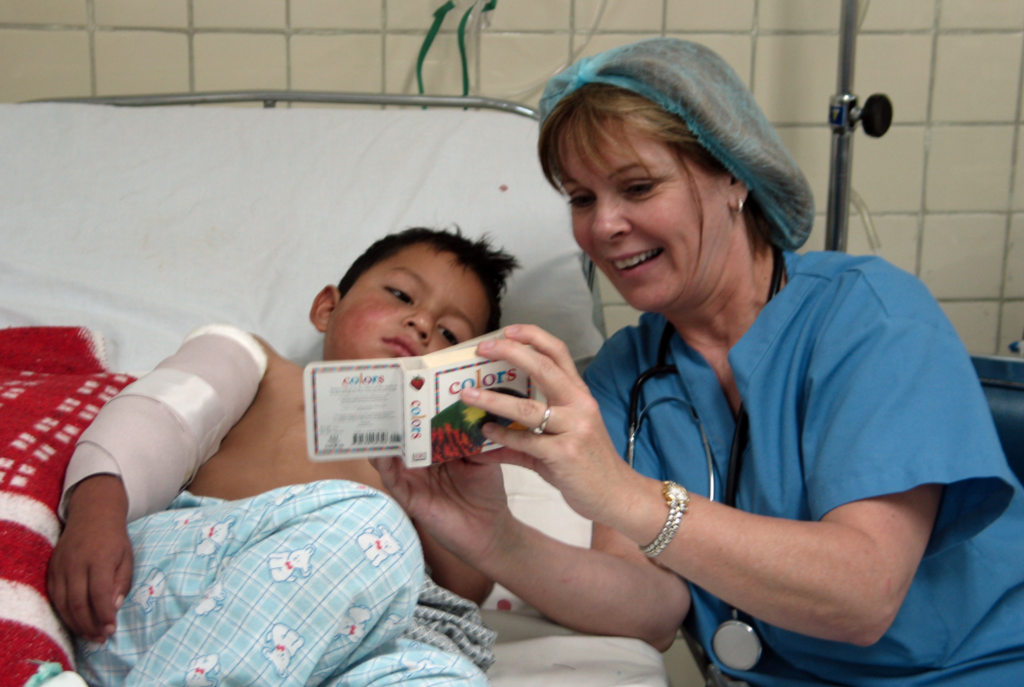

‘Connective labor’ is the real work that lies ahead
The Last Human Job: The Work of Connecting in a Disconnected World by Allison Pugh. Princeton University Press, 2024. 384 pp., $29.95
To all my faculty friends in higher education whose love of teaching and students drives them to gnash their teeth at the mention of increasing student learning assessment metrics; and to all the doctors in my family whose desire to help and heal is often frustrated by systemic straitjackets of insurance billing and relentless expectations to see more patients in shorter periods of time: This book raises a glass to you.
And to all the therapists and people of the cloth who have sat with me, silent but fully present, attuned to the vibration of my unspoken emotions; and to the night nurse who offered me a blanket on that cold December evening in the hospital room where I kept vigil: This book is for you too.
Allison Pugh’s The Last Human Job: The Work of Connecting in a Disconnected World is about the “magic” that can happen when human beings experience genuine encounter in the examination room, the classroom, the helpline, or the hospital bedside—places where feeling “seen” can really matter. Drawing from ethnographic research of workplaces and interviews with over 100 hospital doctors, nurses, home health aides, teachers, therapists and hospital chaplains, Pugh calls this magic “connective labor” and moves it beyond the realm of fuzzy “soft-skills.” Instead, she places it squarely in conversation with the rough-and-tumble realities of social inequality and the incursion of AI technology into services that have long been considered immune to automation and machine-proxies for humans.
The Last Human Job begins with a story: Erin Nash is an apprentice chaplain who intervenes at a moment when a patient is resisting his doctors’ urgings to continue being intubated or face the risk of dying. When Erin witnesses the frustration of this patient who is yelling “Why, why, why” through a tube, she gives him a box of Kleenex to throw against the wall as a way to release his anger. As she does this, the patient grabs hold of her arm, pulls her in, and holds her—for a moment, he is still. “The next time I saw him he was not intubated, and not dying,” she reported. The patient told her, “There is nothing like being in the worst moment of your life and being met with comfort by someone you don’t even know, when you feel like someone understands you.”
Through this vignette, Pugh introduces the concept of “connective labor” as a type of work that involves forging an emotional understanding with another person to create some valued outcome. Intuitively, we may know that a teacher can better help a student learn when engaging with that student as a human being. But the sheer invisibility of connective labor’s value renders it problematic: Engaging a student in this way is not necessary for teaching certification. And yet, Pugh argues, the art of connective labor is the linchpin for the success and effectiveness of any sort of labor that involves working with people. As one primary care doctor said, “80% of what I do is not what I learned in medical school. In some ways I’m more of a therapist or a human connector or something. A relation person.”
While connective labor is usually viewed as a “psychological lubricant to enable the real work of teaching math or lowering blood sugar,” Pugh argues that there are profound, even sacred effects of this mutually created bond because the byproducts of purpose, dignity, and understanding are existentially and societally essential. The experience of seeing truly and being seen, knowing truly and being known, is a potentially transformative experience that leads to a client having an a-ha! moment or a student discovering for the first time that their opinions and voice have value. Through connective labor, people may find their souls opening up in a way they did not know was possible. And with stories like that of Erin Nash, Pugh reminds us that these are the moments of life that make being human—and being human together—frankly, glorious.
At the same time, connective labor is so important that when people do not feel seen or feel “mis-seen” through false assumptions made about them, “it can feel like violence”—especially for people of marginalized populations who have endured repeated encounters of misrecognition already. And in a world where the former sources of social cohesion found through tightly knit family systems and neighborhoods are waning, and the loneliness pandemic and social fragmentation are on the rise, the need for connective labor is ever greater.
We already use catch phrases like empathic listening, emotional attunement, and presence to get at some of the key characteristics of connective labor. But Pugh, an astute sociologist, notes that connective labor is more than a trained skill or innate emotional intelligence. Rather, it is an emergent social process that becomes greater than the sum of its individual actors. Furthermore, the social architecture of any given organization’s resources and culture are what determine a practitioner’s capacity to carry out the connective labor that is essential to their work: Are there leaders who convey a relationship-centered vision and mentors who can shepherd that work? Does the organization share institutional practices that reinforce the vision of empathic emotional collaboration? Do practitioners have reasonable workloads that give them enough time and allow them to focus on one client and their needs?
A 2022 study showed that after the pandemic forty-four percent of K-12 teachers reported burnout and primary care doctors reported “higher levels of stress, depression, and burnout, and lower job satisfaction” than other healthcare workers. While burnout is usually assumed to result from work overloads that outstrip one’s internal resources, Pugh joins recent scholars in conjecturing that burnout stems not from “too much relating” but from a chronic experience of “impeded relationship,” in which workers are constantly struggling to overcome an emotional dissonance between what purpose and dignity they know is possible within their highly-relational work and the frustration of having these possibilities perpetually thwarted by the constraints and norms endemic to their working conditions.
Many of the physicians Pugh studies speak of feeling constrained by systems of data management and time efficiencies. They are dissatisfied when the connective labor they seek is “intermittently interrupted by mandatory work processes they don’t believe in,” such as having to peck away at their screens during patient visits in order to update the cumbersome “EHR” (electronic health record) for billing purposes.
Pugh locates this experience within the wider landscape of contemporary healthcare and education that prioritizes efficiency and productivity over and above relationship and presence. She notes doctors’ felt sense of inevitability when their workplaces become rigid with “measure regimes” and institutional decisions are blind to whatever doesn’t get measured—presumed to be irrelevant and lacking in value.
While her critique of the hegemony of rationalization and quantification is a familiar one (e.g, see philosopher Anton Barba-Kay’s A Web of Our Own Making), the distinctively sociological point that Pugh offers is that “standardization is not just a vector of efficiency, threatening real connection. Instead it can act as a chute of ideologies that are weaponized by the state to define and control marginalized others.” She cites one study that finds time-pressed doctors diagnosing white patients more aggressively and Black patients more conservatively, and then goes on to unpack the ways standardizing tendencies in bureaucracies like Child Protective Services can “shap[e] what practitioners see” and yield consequences of unequal violence especially against low-income people of color.
Once Pugh turns her full attention to AI technology in traditionally human-centered work, she is at her best when she reveals how our societal failure to genuinely address matters of economic disparities are most shamelessly laid bare in the context of how the tech industry talks about AI and therapy bots. Most technologists are prone to assert that even if machines aren’t as good as a human therapist (yet), a therapy bot can at least provide some degree of intervention to individuals who cannot afford a human. The common refrain is “It’s better than nothing.”
While most of us might nod our heads and agree, Pugh asserts that this “better than nothing” argument sounds altruistic but actually yields more inequality. The “better than nothing” logic entails a willful acceptance of existing economic inequalities—rather than summoning the political will to fight against and alleviate it. The “better than nothing” retort is bound by a foregone conclusion about how our society’s talents and resources ought to be allocated: not toward structural solutions but rather toward technological fixes.
Further, Pugh identifies the ways the digital industry’s choruses of praise for the coming replacement of human beings by AI in all manner of human-centered industries are premised on misguided (even ignorant) assumptions about the nature of human beings and what makes us tick. Pugh asserts that it’s not that people simply need to feel “seen” in order to feel motivated to learn, empowered to make change, or experience belonging or healing. Rather, what human beings need is to feel “seen” by another human being.
In fact, even when some might argue that an AI therapist or nurse is superior to human practitioners because they can offer a judgment-free interface or anonymity that frees clients of shame or embarrassment, Pugh sharply points out that apart from the fact that technologies are neither private, anonymous, or judgement-free, “it is not that people prefer to ‘be seen’ by computers rather than people; it is that they prefer them to judgmental or unsafe listeners, as opposed to reflective and empathic ones.” Pugh lands her final punch:
By selling shame-free services, technologists are taking aim at one of the core dilemmas of interpersonal work: the risk of judgment by another human being. Yet, by offering recognition without human judgment . . . engineers are also ignoring something about human value. It is not at all clear that you can have one without the other, because even as the risk of judgment is daunting, it also appears to be part of what makes connective labor powerful.
Here, Pugh plumbs the depths of human relationality with insight into how human validation and a felt sense of recognition happens precisely when you know that someone could have judged and dismissed you, but didn’t. And when that someone chooses to not look away, holding you instead up to the light and honoring your dignity, then transformation is possible. This is why connective labor matters.
The hard-nosed sociologist in Pugh would want us to sit uncomfortably with the possibility that we are a society that will let human contact become a commodity rather than an aspect of human dignity that everyone equally deserves. And the big-hearted person in Pugh would want us to remember the testimonies of ordinary people being extraordinary in their humanity, and hold on to the fact that, at the end of it all, every human being—every student, patient, and client—carries a light of life inside of them that deserves to be seen and honored by someone who carries the same light within. Either way, The Last Human Job stirs us awake. It urges us to not bow to the systems that strip us of our humanity but to continue fighting to find our way to each other, in all our human glory and all our human weakness. For we are all aching to be seen.
Felicia Wu Song is a sociologist, writer, and speaker on the social and cultural effects of digital technology. Her most recent book is Restless Devices: Recovering Personhood, Presence, and Place in the Digital Age.
Image credit: Wikimedia